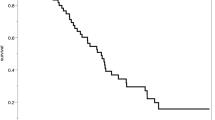Abstract
Unruptured intracranial aneurysms are usually not managed on an emergency basis, although for patients, uncertainty and waiting can be stressful. We assessed the incidence of aneurysms rupturing during the initial period of awareness of having an aneurysm. We studied all patients visiting our service with an unruptured intracranial aneurysm between January 2000 and March 2013. For the exposure time (time between diagnosis and discussion of treatment plan, together with time on waiting list for treatment), we calculated incidence of aneurysmal rupture with corresponding 95 % confidence intervals. We compared this incidence with expected incidence (based on size and site for each aneurysm). 398 patients were included; five had aneurysmal rupture during the exposure time. The observed incidence of aneurysmal rupture during exposure time was 47/1,000 patient-years (95 % confidence interval 15–111); the expected incidence was 0.7/1,000. Our data suggest that the risk of aneurysmal rupture early after detection of unruptured aneurysms is higher than expected based on aneurysm characteristics.

Similar content being viewed by others
References
Nieuwkamp DJ, Setz LE, Algra A, Linn FH, de Rooij NK, Rinkel GJ (2009) Changes in case fatality of aneurysmal subarachnoid haemorrhage over time, according to age, sex, and region: a meta-analysis. Lancet Neurol 8:635–642
Vlak MH, Algra A, Brandenburg R, Rinkel GJ (2011) Prevalence of unruptured intracranial aneurysms, with emphasis on sex, age, comorbidity, country, and time period: a systematic review and meta-analysis. Lancet Neurol 10:626–636
Gabriel RA, Kim H, Sidney S, McCulloch CE, Singh V, Johnston SC et al (2010) Ten-year detection rate of brain arteriovenous malformations in a large, multiethnic, defined population. Stroke 41:21–26
Qureshi AI, Chaudhry SA, Rahim B (2013) Psychological stress and unruptured intracranial aneurysms. Neurosurgery 73:E194–E195
Wiebers DO, Whisnant JP, Huston J 3rd, Meissner I, Brown RD Jr, Piepgras DG et al (2003) Unruptured intracranial aneurysms: natural history, clinical outcome, and risks of surgical and endovascular treatment. Lancet 362:103–110
Henderson KM, Clark CJ, Lewis TT, Aggarwal NT, Beck T, Guo H et al (2013) Psychosocial distress and stroke risk in older adults. Stroke 44:367–372
Vlak MH, Rinkel GJ, Greebe P, van der Bom JG, Algra A (2011) Trigger factors and their attributable risk for rupture of intracranial aneurysms: a case-crossover study. Stroke 42:1878–1882
Koffijberg H, Buskens E, Algra A, Wermer MJ, Rinkel GJ (2008) Growth rates of intracranial aneurysms: exploring constancy. J Neurosurg 109:176–185
Conflicts of interest
None.
Ethical statement
This study has been approved by the appropriate ethics committee and has therefore been performed in accordance with the ethical standards laid down in the 1964 Declaration of Helsinki.
Author information
Authors and Affiliations
Corresponding author
Rights and permissions
About this article
Cite this article
Geurts, M., Timmers, C., Greebe, P. et al. Patients with unruptured intracranial aneurysms at the waiting list for intervention: risk of rupture. J Neurol 261, 575–578 (2014). https://doi.org/10.1007/s00415-013-7238-y
Received:
Accepted:
Published:
Issue Date:
DOI: https://doi.org/10.1007/s00415-013-7238-y




